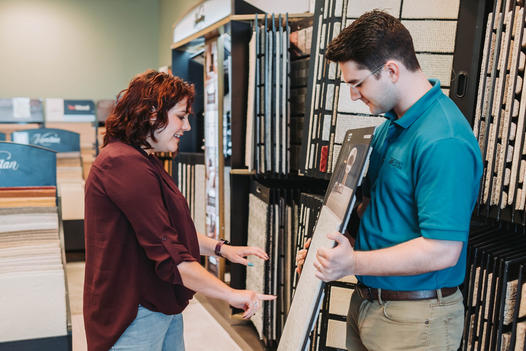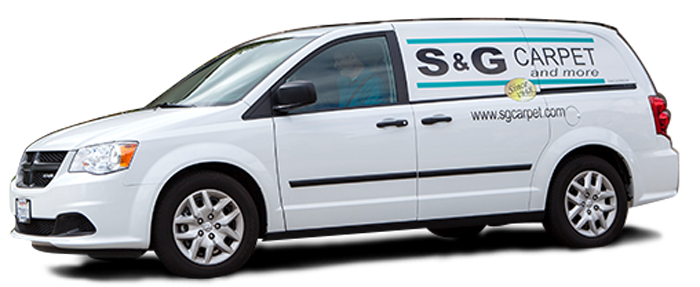Before you begin shopping for flooring, you need a rough estimate of how much you need and a cost estimate.
Buying Guide for Sheet Vinyl, Luxury Vinyl Plank, Luxury Vinyl Tile, and Waterproof Core Flooring
Buying, Installing, and Maintaining Your Vinyl Flooring
The variety of vinyl products on the market make choosing the right flooring for your space overwhelming. We are here to make it easy and clear up any confusion about the different vinyl products available, and provide good information you can use to guide your decision. If after looking at this article you still have questions, please reach out to one of our showrooms and one of our trained consultants will be happy to guide you to the best floor for your space.
Three Types of Vinyl Flooring
One of the primary reasons that there is so much confusion around vinyl flooring is due to the variety of vinyl products on the market. Let’s clear that up so as you shop for the best vinyl floor for your space, you know what kind you should be prioritizing.
3 Vinyl Flooring Types
- Sheet Vinyl
- Luxury Vinyl Plank/Tile
- Waterproof/Rigid Core
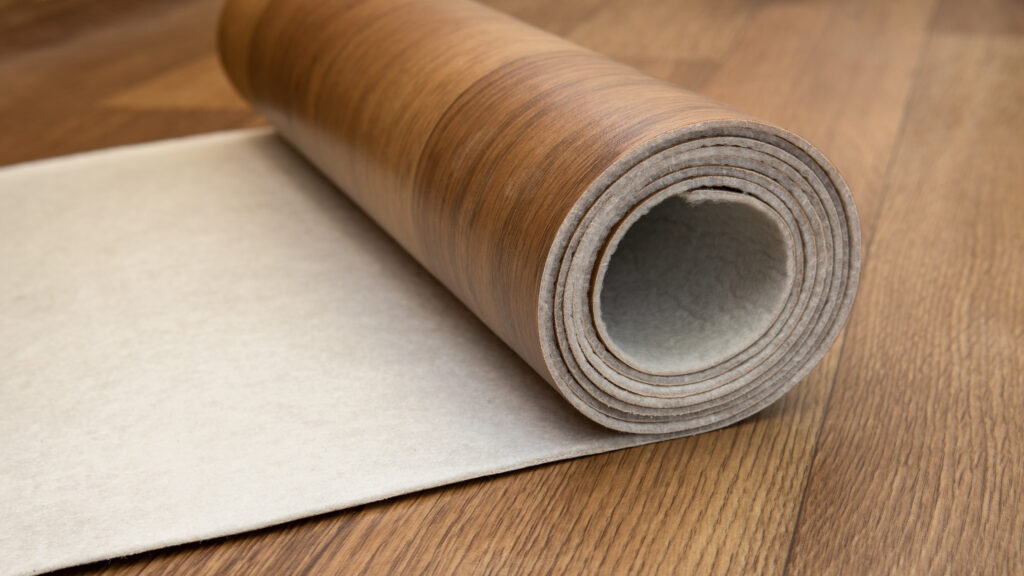
Sheet Vinyl
The first version of vinyl was sheet vinyl, which comes in large rolls that are cut to fit the space and glued down. Sheet Vinyl flooring is waterproof, but it is prone to scratches and dents, especially from rooms with heavy furniture or heavy traffic. Sheet vinyl comes in a huge variety of styles and patterns with photo realistic prints and is often used in places like bathrooms or laundry rooms.
Sheet vinyl has layers to make it resistant to staining, but discoloration over time due to sunlight exposure should be expected.
Luxury Vinyl Plank & Tile
Luxury Vinyl Plank or LVP is similar to sheet vinyl but it has additional layers and is cut into sizes that create planks or tiles (Luxury Vinyl Tile). This allows the floor to mimic natural flooring like wood or stone.
Traditional LVP is flexible and must be glued down, making it popular for spaces with a lot of traffic such as in commercial areas. LVP is used in residential applications when there are heavy items such as carts, wheelchairs, etc. being moved regularly. This allows for a wood or stone like appearance that is waterproof and cheaper than the natural product it looks like.
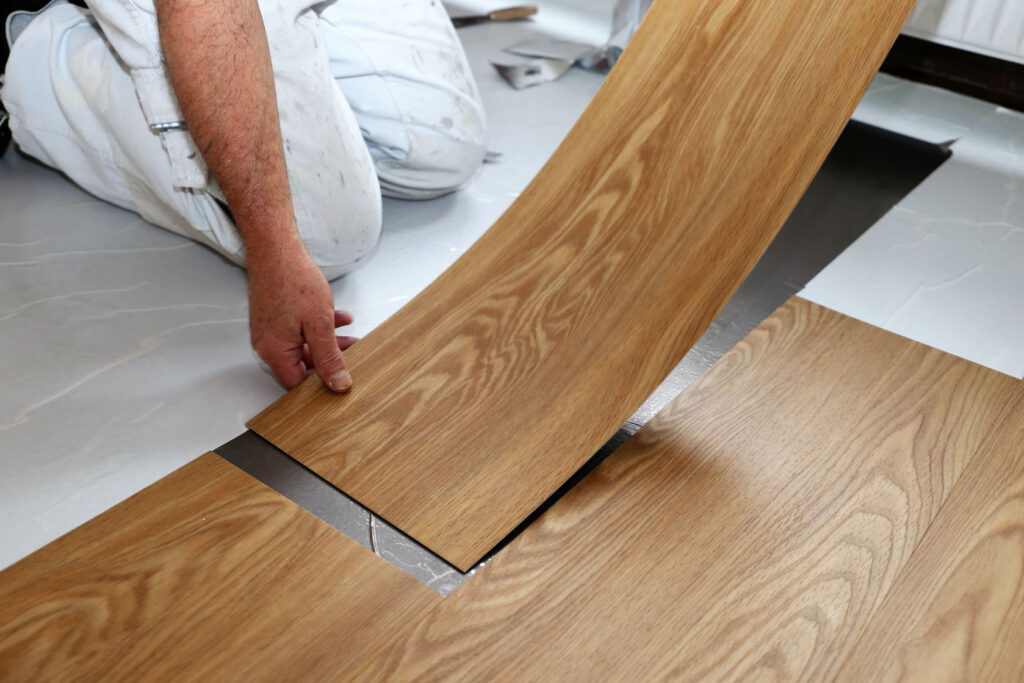
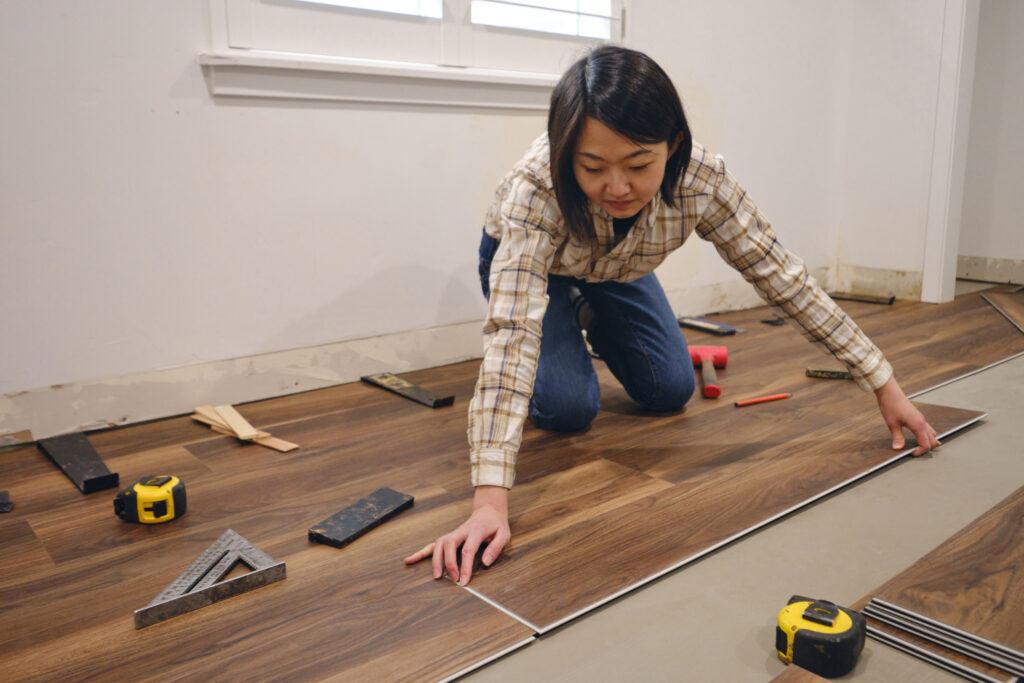
Rigid Core, Click Together, Waterproof Core, & More
This last category goes by many names with small differences between them but ultimately all produce a rigid core LVP product. They are all made of different layers of materials with a vinyl photo on top to create the desired appearance.
Most products use a plastic or stone core, but there are other versions as well. They are all designed with a core that will not absorb moisture, a common issue with hardwood and laminate products. This is what allows the flooring to be rigid like hardwood or laminate, but be waterproof like other vinyl products. Similar to other products, there is a vinyl photographic layer that makes the flooring look like a natural product, and can even have embossing for a realistic feel.
With the flooring being thicker due to the additional layers and waterproof core, this flooring can be installed with a click or snap system. This is why the flooring is commonly called click-together and is often marketed as being very easy to install because there is no glue or specialized tools required to put the planks or tiles together. This sounds like the easiest flooring to install but there are other requirements that make it more difficult as described in the installation section below.
All Vinyl Flooring is Waterproof
By the nature of the method and materials used in vinyl flooring construction, all types are considered waterproof. Most manufacturers say waterproof up to 48-72 hours before a splill needs to be cleaned up.
Some flooring can not be wet-mopped without damaging it and others can. It’s important to know the difference so you can care for your flooring properly.
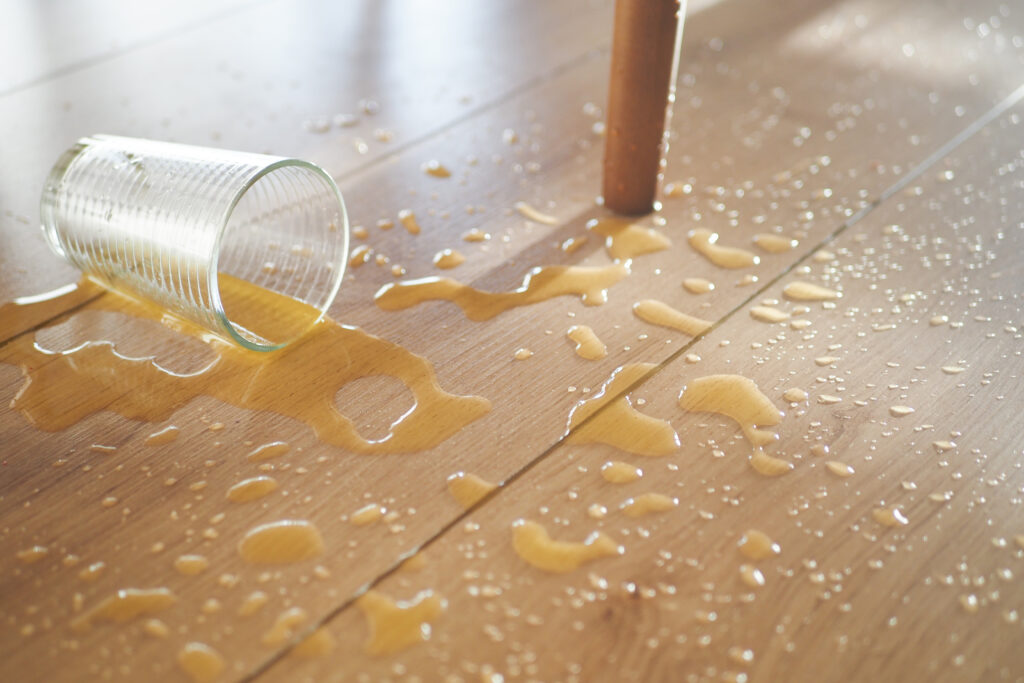
Different Ways to Install Vinyl Flooring
There are two different ways to install vinyl flooring, it is either glued down using various methods depending on the product or it is floated using a click-together system. Each of these have their own set of benefits and drawbacks both from how easy it is to install and what sort of traffic it can withstand which we will outline below.
Keep in mind this is a general guide and your local flooring expert is going to be able to make a strong recommendation for what is right for your space.

Glue Down Sheet Vinyl Flooring
Gluing down Sheet Vinyl can be done in a few ways, making this one of the most DIY friendly options. Sheet vinyl can be installed by securing it to the subfloor with a single line of glue at the entryway, gluing the entire perimeter, or how S&G always does it, gluing down the entire sheet to the subfloor. As with all vinyl flooring, this does require the floor to be level to avoid the sheet vinyl from showing dips or bumps.
Glue Down LVP or LVT Flooring
Installing Luxury Vinyl Plank (LVP) or Luxury Vinyl Tile (LVT) is similar in that it requires glue, but it requires more skill than laying sheet vinyl. Installers need to consider what patterns to place next to each other, glueing the planks together without gaps, and ensuring the arrangement is correct. It also requires a heavy roller to ensure the glue properly adheres to the subfloor so the flooring stays there for years to come.
Floating Waterproof Core / LVP / Click-Together Flooring
Floating installations are deceivingly tricky, not because the click systems can be finicky (on cheap flooring) but because some steps, like properly leveling the subfloor, are more difficult than it would appear.
The basic steps for installing a floating floor is to prepare the subfloor so it’s extremely flat, lay any underlayment as needed, click together the floor remembering the appropriate expansion gaps and transitions. This click feature is why they are sold as easy to install, but the floor preparation required for this flooring makes it a challenging project for most DIYers.
We Install All Types of Vinyl Flooring
Glue-Down or Floating Installations for Sheet Vinyl, Luxury Vinyl Planks (LVP), and Luxury Vinyl Tiles (LVT), and Waterproof Core
Floating installations are deceivingly tricky, not because the click systems can be finicky (on cheap flooring) but because some steps, like properly leveling the subfloor, are more difficult than it would appear.
The basic steps for installing a floating floor is to prepare the subfloor so it’s extremely flat, lay any underlayment as needed, click together the floor remembering the appropriate expansion gaps and transitions. This click feature is why they are sold as easy to install, but the floor preparation required for this flooring makes it a challenging project for most DIYers.
Vinyl flooring is known for it’s waterproof qualities and can be installed in all types of spaces as well as above, on, and below grade. This makes it an ideal product to have in your home as it looks natural with the durability of a manufactured material. With S&G’s Lifetime Installation Warranty you can rest assured that it will be installed correctly and timely, and should something happen in the future we will make it right.
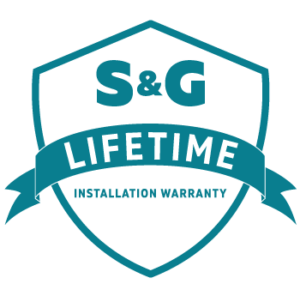
S&G Carpet offers a free lifetime installation warranty on all owner-occupied residential flooring installations. This means that whether it’s 1 or 10 years later, if something about your flooring is failing due to improper installation we will come out and fix it at no cost to you.
This covers things like carpet restretching, hard surface planks lifting, or even baseboards coming off a wall. We stand behind the craftsmanship of our work as long as the purchaser is living on the floor, you’re covered!

Which Vinyl Flooring Products Are Right Which Spaces In Your Home?
When considering carpet vs hard surface most people know that carpet isn’t suited for every room in the home, but the same consideration isn’t always given to hard surface products such as hardwood, laminate, sheet vinyl, LVP, or waterproof core. Choosing the correct product type is paramount to getting the performance you desire out of your floors.
It’s common for customers to see “waterproof” or “pet friendly” and assume it’s the best flooring for their space. There is a myriad of considerations for your flooring and there is no one size fits all recommendation. That’s where a trained flooring consultant can help guide you to the best floor for your space and needs. We encourage you to stop by a showroom or try our free shop at home program.
In the meantime, we hope this short guide will help you find what’s the best for your space.

Best Spaces to Install Sheet Vinyl
Sheet vinyl flooring is affordable and makes a great waterproof floor option. The primary downside of sheet vinyl is it’s susceptible to cuts, knicks, and tears. This is most apparent in rooms like kitchens where traffic can be high, dropped items can cause damage, and if there are pets in the home that run through the space they are very likely to tear the flooring. Depending on the pattern chosen, things like small cuts may be hidden, but it’s important to know how the flooring is going to perform and choose what’s best for your space.
For these reasons sheet vinyl is recommended for spaces like kitchens, bathrooms, laundry rooms, and pantries.
Installing sheet vinyl is likely to show many marks and tear if installed in higher traffic spaces like bedrooms, stairs, dining rooms, living rooms, mud rooms, commercial spaces, or when accommodating wheelchairs.
Areas Sheet Vinyl Performs Well
- Kitchens
- Bathrooms
- Bedrooms
- Laundry Rooms
- Pantries
Spaces to Install Luxury Vinyl Plank & Luxury Vinyl Tile
Luxury Vinyl Plank (LVP) and Luxury Vinyl Tile (LVT) have additional layers compared to sheet vinyl and is more resistant to knicks, scratches, and denting. LVP and LVT is very popular in areas where there is significant foot traffic, commercial spaces, or where traffic from wheelchairs or push carts is expected.
LVP is very versatile in that it can perform well in all spaces, which may lead you to believe that it’s the best flooring type available. Simply put, there are other products available that are more realistic and desirable.
Areas LVP/LVT Performs Well
- Kitchens
- Bathrooms
- Living Rooms
- Dining Rooms
- Bedrooms
- Mud Rooms
- Laundry Rooms
- Pantries
- Wheelchairs
- Heavy Carts
- Commercial Spaces
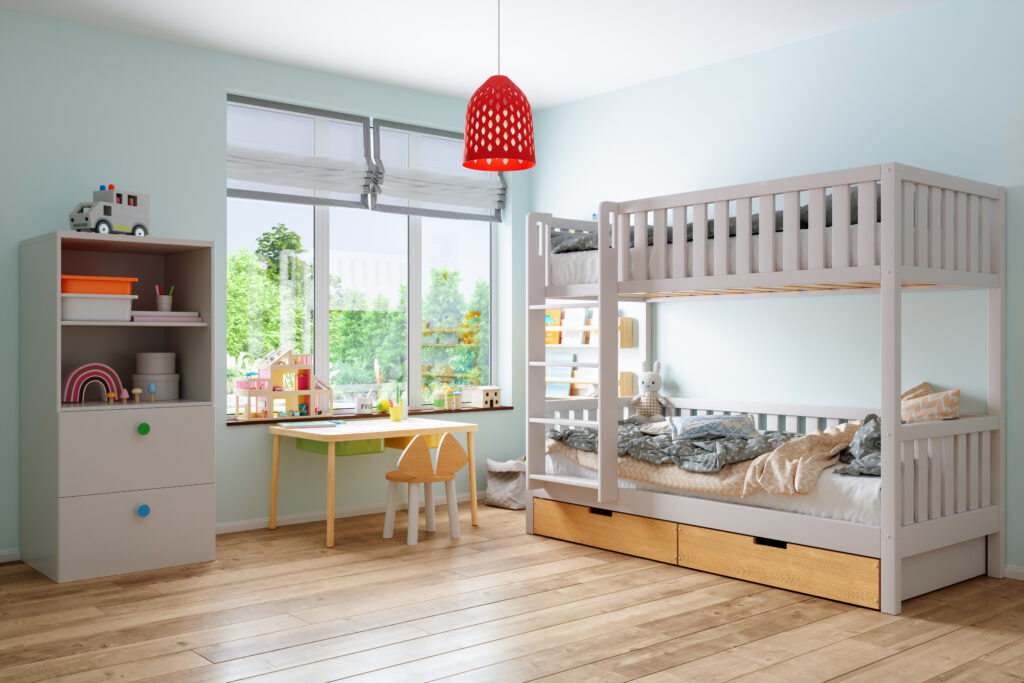
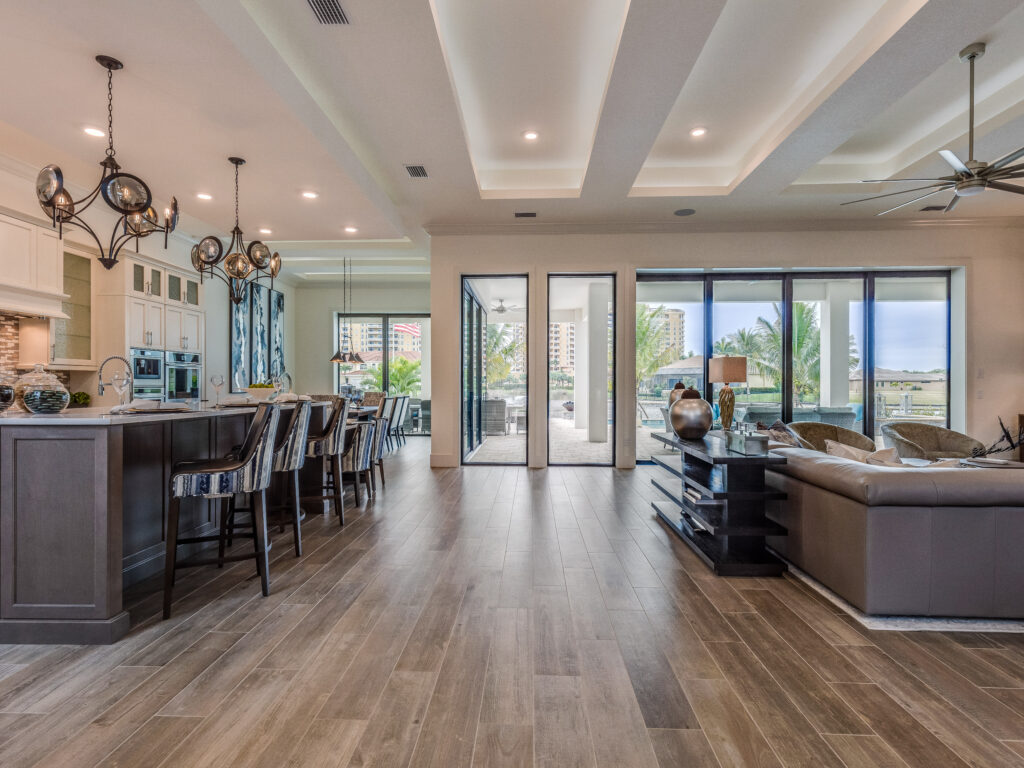
Rooms to Install Waterproof Core / Rigid Core / Click-Together Flooring
Waterproof Core products can feel more like natural products because of Embossed In Register (EIR), and it comes on a rigid plank instead of the flexible LVP/LVT and sheet vinyl.
Waterproof Core is limited in the areas and applications due to the floating installation and click-system. Waterproof Core is great for bedrooms, kitchens, bathrooms, stairs with squared noses, dining rooms, living rooms, laundry rooms, pantries, and mud rooms.
Rigid core products are not recommended for commercial applications or if wheelchairs or other heavy equipment regularly travels over the flooring. The click-together systems fail in these scenarios and the planks will start coming apart.
Areas WPC, WPC, and Rigid Core Performs Well
- Kitchens
- Bathrooms
- Living Rooms
- Dining Rooms
- Bedrooms
- Mud Rooms
- Laundry Rooms
- Pantries
Maintaining and Cleaning Vinyl Flooring
One of the big draws of vinyl flooring is the ease of maintenance, and it can be made even easier by being informed. The list of things that you are told you can and cannot do in order to get the best from your new floors can be daunting. We make it easy and break it down to exactly what you need to know along with recommendations that are easy to follow.
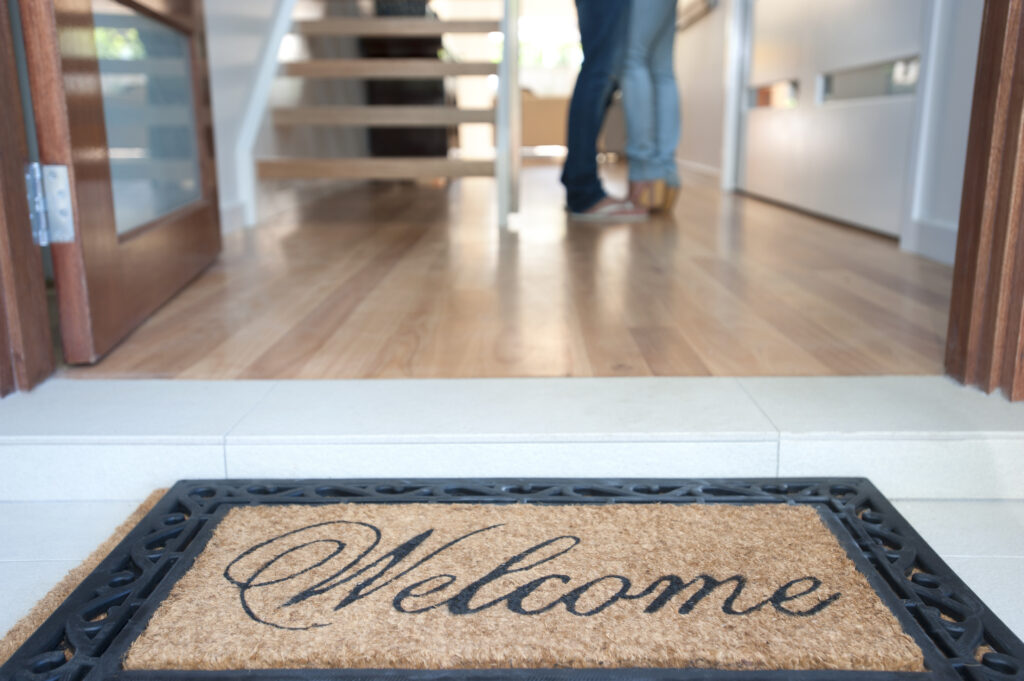
Remember to Use Mats
Using walk off / door mats at every entrance to the home means most soil will be caught before it gets inside. You want these to get all the gritty things that could get stuck in your shoe and cause scratching when you walk around in your home.
When choosing indoor mats, pick ones that do not have rubber, latex, or cocoa fibers as the bottom. Using products like these could cause the flooring to discolor.
Heat & Direct Sunlight Damages Vinyl Flooring
All vinyl flooring is susceptible to fading and damage due to direct sunlight over time or extreme heat. We recommend using blinds or curtains to protect your flooring. Sometimes the fading isn’t obvious until you move a mat or see it side by side with another piece of flooring, but it’s something to be aware of and take steps to mitigate.
Furniture Protection for Vinyl Floors
No flooring is scratch proof, which means that we recommend using felt or plastic leg protectors for furniture so when they are moved they do not scratch the vinyl flooring. Some furniture has casters or wheels on the legs. If this is the case most manufacturer warranties require the casters are 1” wide continuous and kept clean. We always recommend you check the manufacturers warranty for the exact requirements for your specific flooring.
Reduce Chances for Scratches and Trim Your Pet’s Nails
Floors can be scratched by a variety of everyday activities such as pets running and playing. It’s important to minimize the odds of scratches and dents by grooming your pets nails regularly. Another concern is shoes that have exposed nail or a boot with a rock caught in the tread could cause scrapes, cuts, and holes in your flooring.
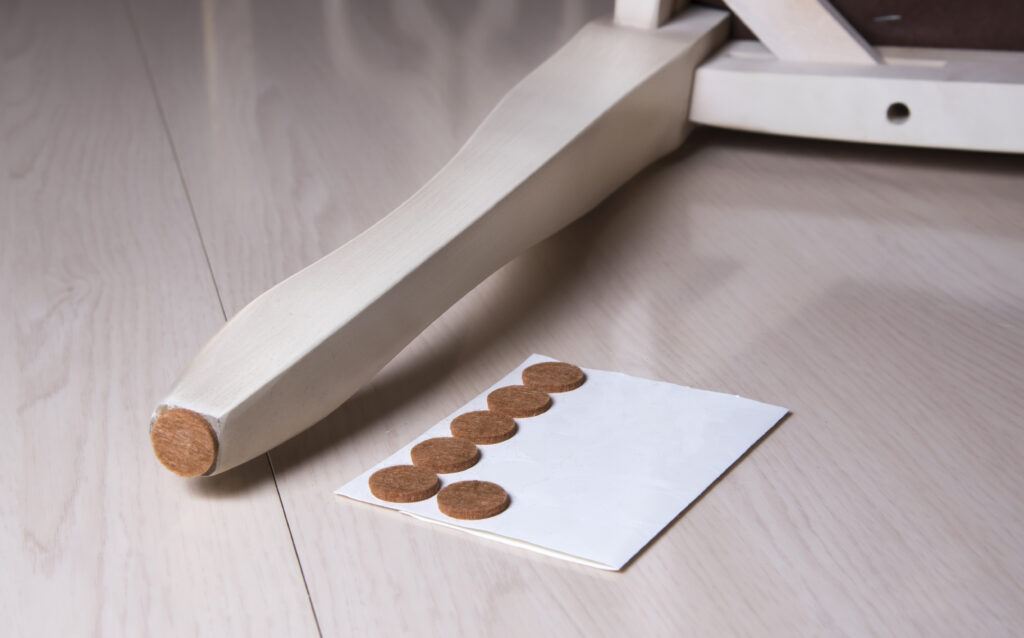
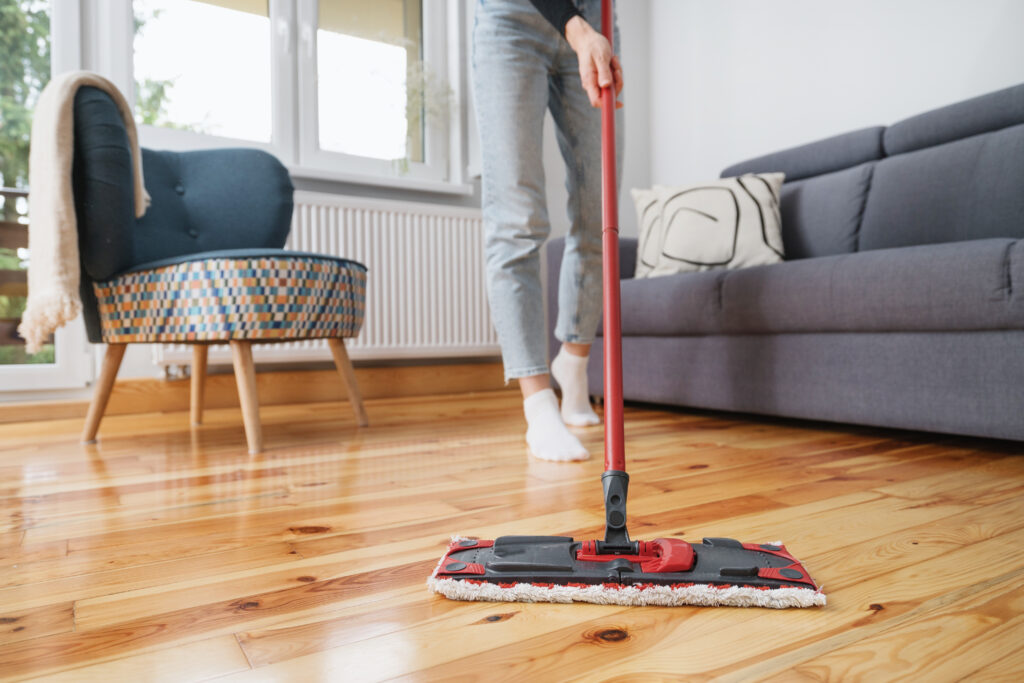
How to Clean and Maintain Vinyl Flooring
Maintaining vinyl flooring varies depending on what kind of flooring you have. Sheet vinyl is very forgiving and can be wet mopped without issues. In contrast, click-together systems cannot be wet mopped and must be washed using a floor cleaner and a dry mop. We often recommend the Bona system, but any ph neutral floor cleaner should work.
It’s important to sweep, dust mop, or vacuum regularly. If you choose to vacuum be certain to turn the beater bar off so it doesn’t scuff your flooring. For a deep clean use a ph neutral floor cleaner such as Bona, or Mannington. Spray it to the mop head and wipe the flooring making certain to wipe in different directions.
If you use a conventional mopping system make sure to not oversaturate the water. Do not use aftermarket cleaners, they often have soaps and detergents that will stick to or damage your flooring. Do not use the abrasive side of the sponge or mophead as it could cause damage to the flooring.
We recommend these steps for cleaning your vinyl flooring including sheet vinyl, LVP, and waterproof core products:
- Sweep or vacuum
- Dry mop with a ph neutral cleaner
- Dry with a towel if needed (such as after mopping sheet vinyl)
What Vinyl Flooring is Right for You?
Now that you have a stronger understanding of the different types of vinyl, you should have an idea if vinyl flooring is right for your space and which type is likely to suit your needs. That’s not to say your new flooring journey is over, even armed with the knowledge you now have, it is easy to miss additional considerations for your project. That’s because each home project is unique, and has different requirements for the space it’s being installed into beyond just the lifestyle needs and preferences you have.
This is a large driver of why we always encourage a consultation with one of our experienced and trained flooring consultants. Speaking about your project with an S&G Consultant means you are working with someone who understands all the steps of the process and can help advise you so you make the best decision for your space and lifestyle. We boast decades of experience and have the most rigorous training program in the industry so you can rest assured, our consultants are well informed and equipped to make your flooring dream a reality.
Specifically with vinyl flooring, choosing the correct type of product can make the difference between decades of satisfaction or years of issues that keep coming up because the wrong type of flooring was installed into the space, or the wrong installation method was used.
There are many benefits of vinyl flooring and the click-together systems are very popular, but that doesn’t mean it’s an automatic best choice for everyone. We always recommend discussing your project with a trained consultant who can understand your specific needs and make a recommendation based on that.
S&G Carpet offers Free Shop at Home consultations where you can see a variety of flooring types, go over the benefits, and make it easy for you to make the right decision.
